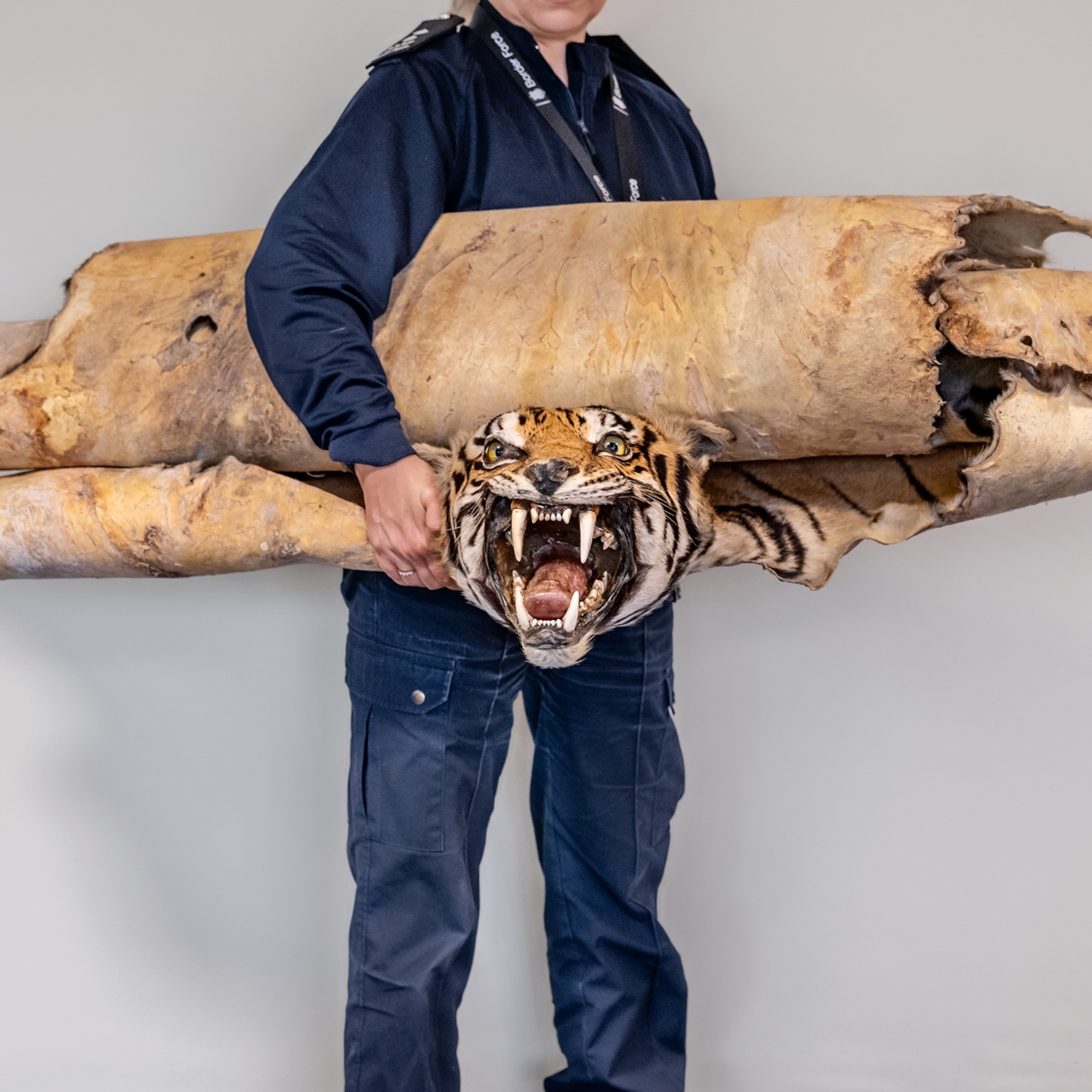
Poached for Its Horn, This Rare Bird Struggles to Survive
The mysterious helmeted hornbill fades from Southeast Asia’s forests as poachers and traffickers target it for the illegal wildlife trade.
This article was produced in collaboration with the Cornell Lab of Ornithology and is part of a multimedia effort to raise international awareness about the plight of the helmeted hornbill.
I have come to this steaming forest to find a bird. I’m starting to wonder if it’s worth it.
The terrain in Budo-Su-ngai Padi National Park in southern Thailand is so steep in places that you can reach out and touch the path in front of you. With each step on the rain-drenched ground, you risk sliding back down. Insects buzz in nose and ears, and if you stop long enough to look around, you’ll see an army of land leeches inching their wormy, blood-hungry little bodies toward you.
The bird my fellow trekkers and I are after is the ancient, bizarre-looking, and now increasingly rare helmeted hornbill. The leader of our group is Pilai Poonswad, a Thai scientist known as the “great mother of hornbills.” She’s been studying the birds, and working to protect them, since 1978. Photographer Tim Laman is with us, as are a videographer, several members of Pilai’s team, and some people from the village at the bottom of the mountain who are carrying supplies and will help set up our camp. We knew it would be a slog—these birds are shy to begin with, but the growing rate of decline makes finding them something of an odyssey.


When we finally reach the tree we’ve been aiming for, we hole up in a blind about 130 feet away made of camouflage fabric and bunches of branches. The tree is a dipterocarp, a tropical hardwood, maybe 180 feet tall, that towers above most others in the forest. Jutting from its side a little more than halfway up is a gnarled cavity in which a female hornbill had sealed herself a few months earlier to lay an egg. From our spot on the ground we can’t see in, but we know it’s only a matter of time before papa hornbill swoops in to deliver a meal.
Hours tick by as we wait, occasionally whispering but mostly daydreaming away the giant forest ants (up to an inch long with intimidating but, I was assured, harmless pincers), those resolute leeches, and the unforgiving plywood we’ve turned into a bench. At one point a spider the size of my thumbnail drops down in front of me, clinging to its line of silk. We stare at each other for a while before it jumps at my face—a narrow miss. The sun’s still making its way upward, but already the humidity has wrapped me in a wet, clinging hug.
I’m not a bird-watcher, but this must be bird-watching at its most dedicated.

THE YEAR OF THE BIRD
National Geographic is partnering with the National Audubon Society, BirdLife International, and the Cornell Lab of Ornithology to celebrate the centennial of the Migratory Bird Treaty Act. Watch for more stories, books, and events throughout the year.
My reverie is broken by a rush of air overhead—Whoosh-whoosh-whoosh! The gaps between feathers in their wings make hornbills some of the noisiest fliers around.
Hoo. Hoo. Hoo-hoo-hoo, Hahahaha! It’s the maniacal laughter of a helmeted hornbill. By the sound of it, this one is only a few trees away. We hold our breath. And suddenly, there it is: A living dinosaur, some four feet long (not counting its foot-long central tail feathers), perched on the protruding knot, a large stick insect dangling from its mouth, its beady eyes observing the surroundings.
Everything around me hushes. The itchy heat is gone, the stomach-churning throbbing in my ankle (sprained a few days earlier back home in Washington, D.C.) ceases. There are no more bugs, no more cicadas screaming.
We stare at that massive head, heavy with its red “helmet”—or casque—atop a wedge of yellow beak. We take in the featherless, wrinkled red neck, the long black-and-white banded tail feathers, the sheer heft of the bird. It’s an otherworldly vision—like seeing the Grand Canyon for the first time. Nothing prepares you for the overwhelming sense of wonder you feel when you peer over the rim.
The hornbill bends over the nest cavity and passes off the stick insect to his chick through the opening. Mission accomplished, and with another whoosh of those wings, he’s gone—off no doubt to search for more food for his family.
The helmeted hornbill, one of 57 hornbill species in Africa and Asia, is found only in the lowland forests of Brunei, Indonesia, Malaysia, Myanmar, and southern Thailand. Helmeted hornbills stand apart from the other hornbills because their casques are mostly solid with a thick layer of keratin, the same material as fingernails, hair, and rhino horn. Not much is understood about helmeted hornbill behavior, but they’re known to use their casques to joust while in flight, perhaps in competition for nesting sites or fruit trees.
The birds are omnivorous but favor the fruit of strangler figs, which start as a seed in the canopy of a host tree and send roots downward, slowly encasing and killing the tree. Strangler figs, when fruiting, serve as the rain forest’s grocery store for the menagerie that feasts on the ripe fruit—from tree shrews, giant squirrels, gibbons, and orangutans to nearly a thousand species of birds.
Hornbills are vital to the survival of Southeast Asia’s forests. As “farmers of the forest,” they disperse seeds by regurgitating or defecating them, helping to replenish trees over several square miles. It’s an especially important task now, given how much primary forest has been cleared by commercial enterprises. Widespread logging also is reducing habitat for Asian hornbill species and threatening their ability to nest.


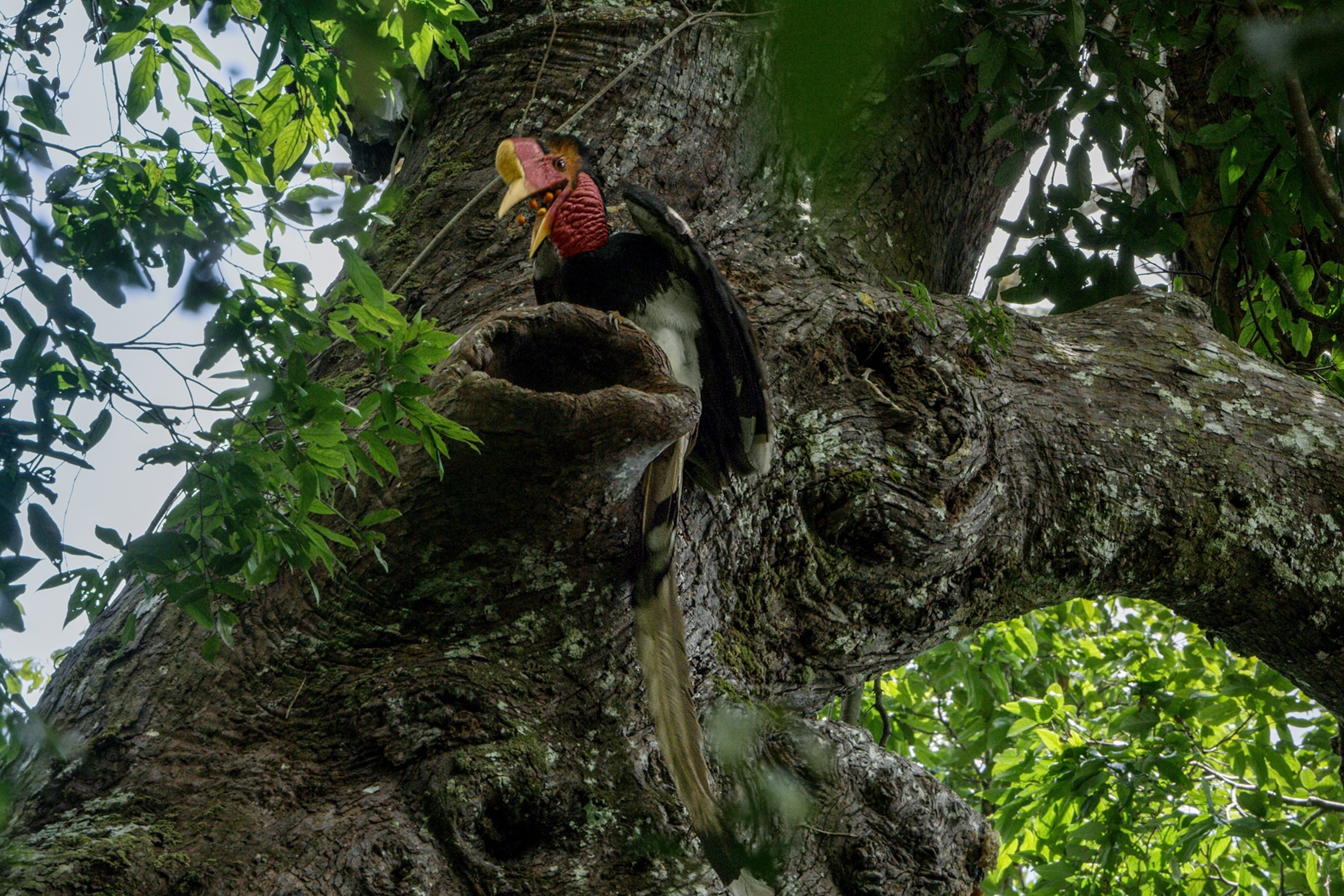
Helmeted hornbills are especially picky, requiring huge trees with a hollow cavity to nest in. Those happen to be the oldest and biggest in the forest—and are therefore highly valued by loggers. The birds are slow to reproduce, breeding once a year and raising only one chick. Because the mother and the chick live sealed inside the nest cavity for some five months until the youngster is ready to fledge, they depend on the male to feed them. If the male is killed—shot by poachers for his casque, for example—the rest of the family will likely die.
Softer than ivory and easily carved, hornbill casques are in high demand in Asia, to be fashioned into beads, pendants, and intricate works of art. For a subset of China’s wealthy class, rare wildlife products such as helmeted hornbill carvings, elephant ivory, and rhinoceros horn can be a sign of money, power, and luxury.
Scientists aren’t sure exactly how many helmeted hornbills survive, but it’s clear from recent research and law enforcement operations that they’re in trouble. In 2016 the more than 180 parties to the Convention on International Trade in Endangered Species of Wild Fauna and Flora, the treaty that governs the international trade in wildlife, approved a proposal calling for stronger protections for the birds, which have been illegal to buy and sell internationally since 1975. In acknowledgment of this dangerous level of poaching, their conservation status recently shot up from near threatened to critically endangered, a jump of three levels and only one away from extinct in the wild. In every country where helmeted hornbills are found, they’re protected by national laws, but Indonesia has emerged as a poaching hot spot.
Indonesian law enforcement first became aware of large-scale helmeted hornbill trafficking in 2012, when natural resources officers at an airport in West Kalimantan, a province on the island of Borneo, stopped two Chinese women from smuggling 96 casque pieces out of the country. Soon more confiscations followed, with some seizures of casques numbering in the hundreds. The Environmental Investigation Agency (EIA), a U.K.-based nonprofit that has been tracking seizures along with the wildlife-trade monitoring organization Traffic, says these seizures likely represent a fraction of the helmeted hornbill casques being traded.
Some thousand miles south of the forest in Thailand where we watched the papa hornbill deliver a meal, there’s a storage room in a government office in the Indonesian capital of Jakarta. Behind the door are stuffed tigers and sun bears in varying poses of ferocity, the shell of a sea turtle mounted on the wall, cardboard boxes overflowing with tiger skins and elephant ivory—and suitcases filled with more than 240 neatly stacked helmeted hornbill casques, all seized from wildlife traffickers.
Indonesian authorities have confiscated more than 1,300 helmeted hornbill casques in all, many seized from smugglers linked to organized criminal syndicates that traffic in commercial-level quantities of endangered wildlife parts. The government plans to destroy these caches eventually to prevent them from making their way back onto the black market. But in the meantime hornbill researcher Yokyok Hadiprakarsa is visiting stockpiles around the country to measure the casques in order to better understand the physical variations of these birds.
Laman and I join Yokyok in Samarinda, the most populous city on the island of Borneo, at the regional office of the federal Department of Conservation and Natural Resources. He’s documenting the helmeted hornbill stockpile there. When I walk in, I’m jolted by an incongruous sight. It’s a typical conference room with four long tables forming a square, beige walls, and a window opening onto a view of the small coal mining operation next door. But the eye is immediately drawn to the front, where 101 helmeted hornbill casques are spread neatly on a table, each with a tracking number written in permanent marker on the bottom.
“The opportunity for research for scientific purposes is very limited,” he says, because helmeted hornbills are so hard to find in the wild. “But now, look! You have a hundred here. This is a great opportunity for us to get this information, though at the same time, it’s also very sad.”
One by one, Yokyok places casques on a digital scale, recording their weights in a spreadsheet. It’s Friday, and the adhan, the Muslim call to prayer, is echoing in the background. He also takes photos that software will analyze later to get three-dimensional measurements, so researchers can better understand physical variations of the species.
Yokyok is also working to get permission to extract DNA samples, which would allow him to determine whether a casque is from a male or a female. Comparing DNA with casque measurements would shed light on the differences between male and female beaks and casques, something that’s never been studied in helmeted hornbills before, he says.
Among the Dayaks, the non-Muslim indigenous peoples of Borneo, lore has it that the helmeted hornbill was once a man who hated his mother-in-law. His hatred grew and grew until one day, he snapped. Taking his ax, he chopped down the stilts that held up his mother-in-law’s home, with her inside. The gods punished the man by changing him into the helmeted hornbill, doomed to relive his crime again and again through his call: The accelerating hoos of the helmeted hornbill’s call are the sound of the ax hitting the stilts, and the cackling laughter is his glee when the hut comes crashing down.
“When I first heard it, I thought it was a ghost,” says one young man who accompanies our team deep into the jungle of West Kalimantan to stake out a fruiting fig tree. We’re sitting in the middle of the trail, eating lunch cooked over a portable gas burner. The flies have started in on the rice, and the bees are circling the fish, but no one notices. He says his grandmother used to warn the children that the helmeted hornbill would come in the night and eat little boys’ testicles if they didn’t behave.
The birds have been important to the Dayaks for at least 2,000 years. Their long tail feathers are still used in headdresses, and their casques were carved into ear pendants and other adornments. By the year 700, trade between Borneo and China was flourishing, and in 1371 helmeted hornbill “ivory” was first recorded as reaching China as a tribute gift from the sultan of Brunei. The Chinese, already skilled in the art of carving elephant ivory, transformed helmeted hornbill casques into belt buckles, buttons, bracelets, snuff boxes, and more. Sometimes intricate scenes were carved into a casque that was still attached to the bird’s skull. By the mid-1800s demand had shifted west, and the Chinese imported casques mainly to carve and sell to Europeans.

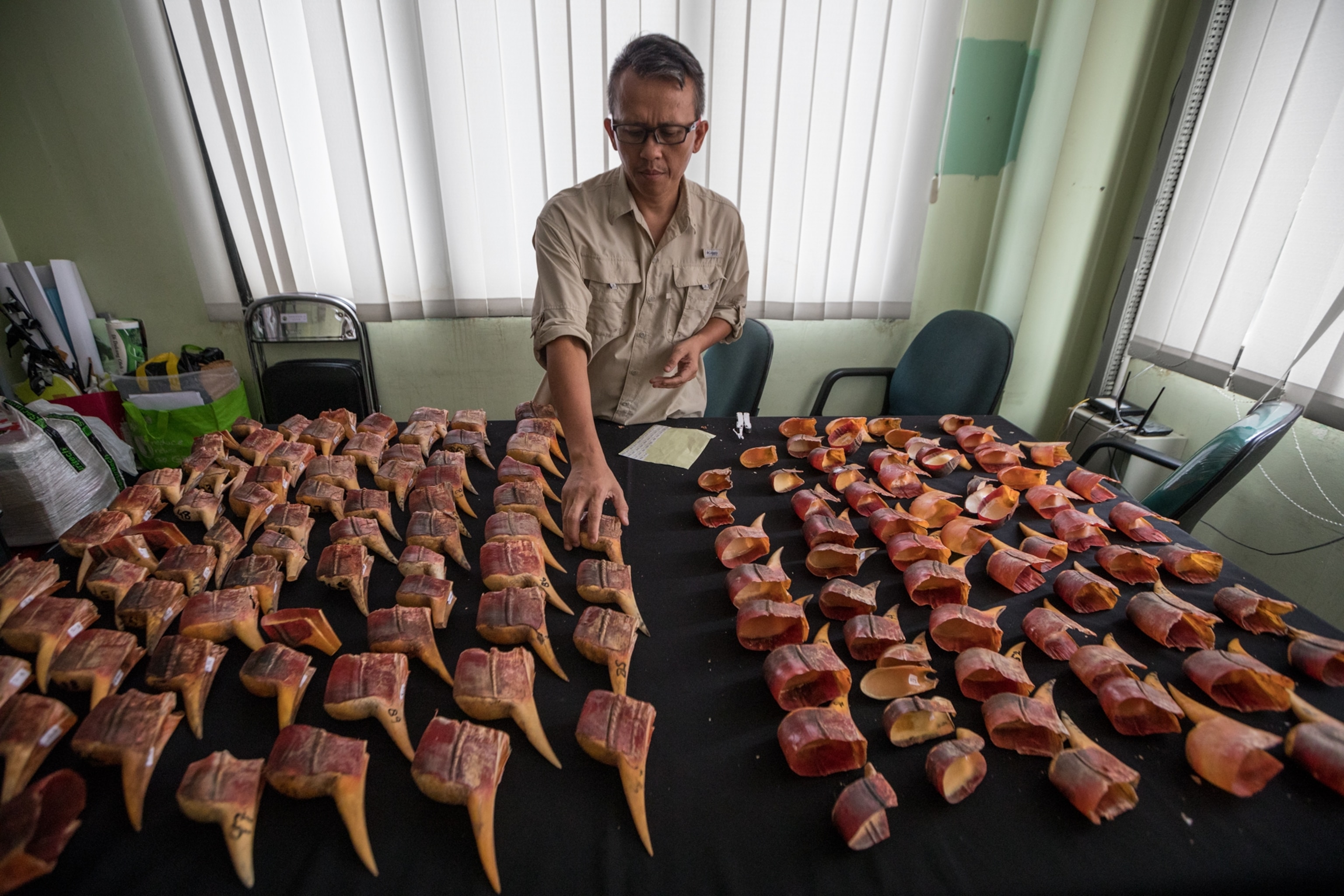
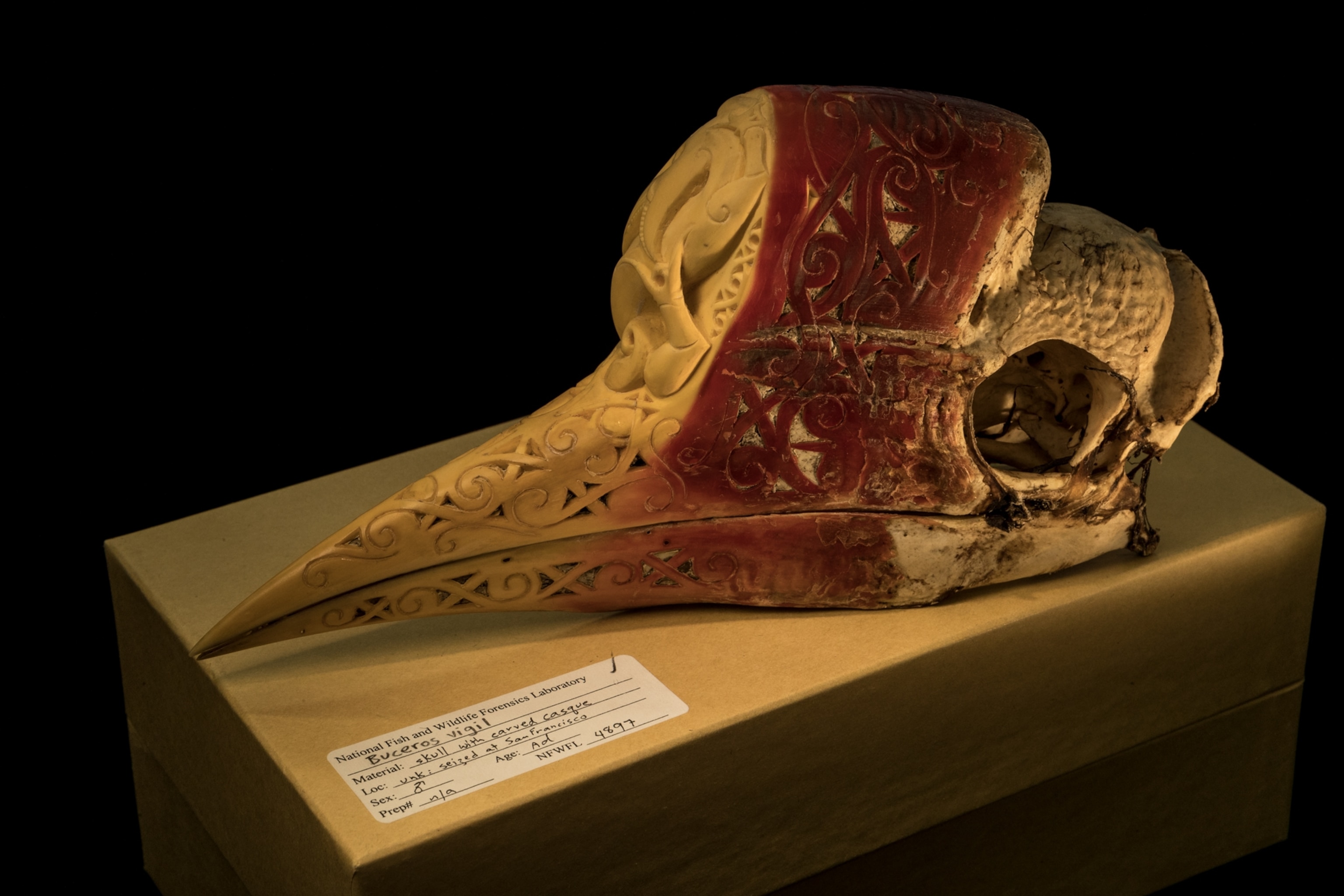
Today helmeted hornbill carvings are once again in high demand in China. It’s not entirely clear why—their rarity perhaps, or novelty value—but the art pieces are popular among some newly wealthy Chinese. Yokyok was among the first to recognize the growing crisis. He says it came to his attention in 2012, when a friend sent him a photo of several hornbill heads for sale in West Kalimantan.
“It was shocking,” he said. “I needed to do something.” He launched an investigation, which led him to conclude that some 6,000 helmeted hornbills likely had been killed in 2013 in West Kalimantan alone.
Some helmeted hornbill poachers are opportunistic hunters who will shoot any animal they can eat or sell, says Dwi Adhiasto, who oversees the wildlife crime units of the nonprofit Wildlife Conservation Society’s (WCS) Indonesia Program. Others, he says, are supplied by organized criminal networks that provide them with guns and gear for expeditions into the forest specifically to hunt helmeted hornbills.
These networks, he explains, mainly target species with a more established illegal trade—such as tigers and the world’s only truly scaly mammal, the pangolin—but they realized they can raise the bottom line by diversifying into helmeted hornbills.
“Tiger fangs, pangolins, and also helmeted hornbill beaks—it’s those three that exist in the criminal networks in Asia operated by Chinese,” Dwi says. The groups typically are headed by a Chinese kingpin who controls sophisticated transnational trade and money laundering schemes, he says. The networks take advantage of the reluctance of law enforcement and the judicial system to treat wildlife crime as seriously as other types of organized crime, such as drugs and human trafficking.
In June 2015 Indonesian authorities arrested two men suspected of smuggling casques in northern Sumatra, an entry point for poachers accessing Gunung Leuser National Park. They were believed to be operating with a team of 30 poachers who hunted inside the park using rifles modified with silencers, according to WCS, which assisted in gathering information. The men confessed to selling at least 124 casques over six months to a Chinese middleman, whom they would contact using a disposable cell phone to avoid detection. During the arrest, authorities confiscated 12 casques, two rifles, a digital scale, and two cell phones.


We meet a hunter from the Dayak Iban ethnic group, who invites us to his village in West Kalimantan. We sit on the floor of his family living area in a modern village longhouse, where many in his community live. Traditionally longhouses are made of ironwood, which is so dense it sinks in water, but his community’s was rebuilt with concrete walls and shiny tile floors.
Pinned to a mirror on a vanity nearby is a photo of him in uniform when he was as a security guard for a logging company in Sarawak, the Malaysian state to the north. He also worked as a cook at a Chinese restaurant in Kuala Lumpur, Malaysia’s capital, but he quit and came home to his village to get married and in hopes of making a better income from hunting, which gives him more freedom and independence.
He can make a lot of money selling fish across the border in Malaysia, he says, and wild boars are good for eating. He insists it was his friend, not him, who shot the young helmeted hornbill whose casque sits on the floor between us, flanked by the skull of a rhinoceros hornbill and the skin and feathers of a wreathed hornbill. They’d eaten the meat of rhinoceros hornbill and wreathed hornbill, but it was too tough, he complains, like a wild chicken. When I ask about the helmeted hornbill casque, he shrugs, explaining that the buyer who comes to their village wouldn’t take it because it was too small.
Before 2012, he says, no one in his community hunted helmeted hornbills—the birds had no value. But these days he and others regularly check fruiting trees, looking for birds with big casques that they lure into the range of an air rifle by imitating their strange call. At most, he says, they’ve hunted two in a day—nothing compared to the 15 or 20 a better equipped group of men he once encountered had in their possession. After they shoot a hornbill, they cut off its head and bring it home. Then they boil it in water to separate the casque from the rest of the skull.
He says he doesn’t know what happens to the casques after the buyer takes them, but wildlife trade experts say the buyer probably goes from village to village, buying casques until he has a sizable collection to sell to a middleman. That person, who’s probably based in a big city, is in charge of getting them out of the country, Dwi says. According to him, casques are most often smuggled to China on commercial airlines, with Hong Kong being a popular waypoint. Each time the casques change hands, their price goes up. The final customer in China is likely paying more per gram for a helmeted hornbill casque than for elephant ivory, according to the EIA.
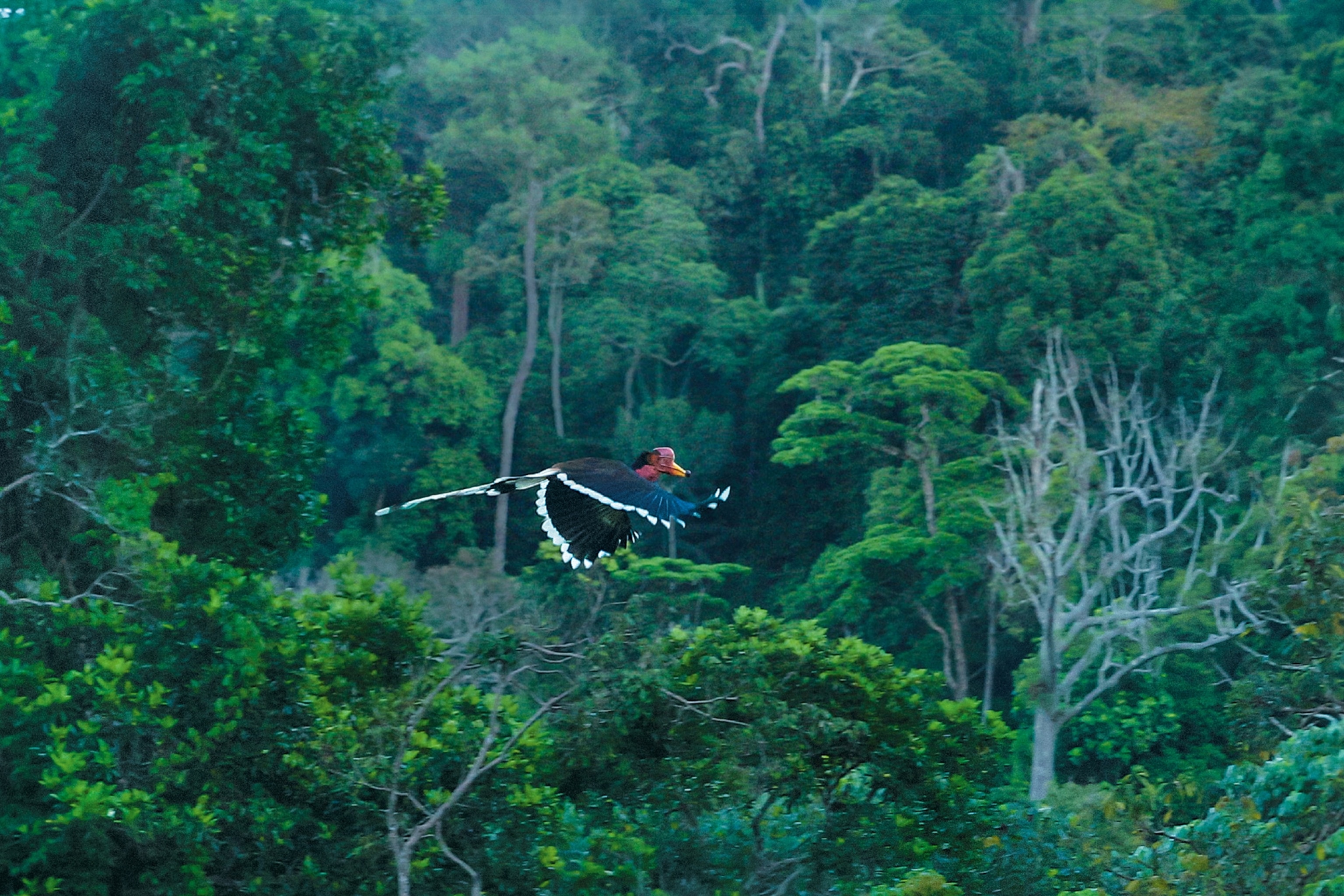
In Budo-Su-Ngai Padi National Park, Pilai Poonswad has developed a model program for protecting hornbills. A parasitologist by training, Pilai became fascinated with the birds in 1978, after guiding a BBC film crew to search for them. She was awed by the sight of a hornbill feeding its family in a tree cavity, and soon after, she founded the Hornbill Research Foundation.
In 1995 she met Asae Jaru, a poacher who would steal hornbill chicks to sell into the pet trade. Pilai realized that many others in the man’s village, which is in a predominantly Malay Muslim region of Buddhist Thailand, were doing the same thing. A man could make more money selling one or two hornbill chicks than he could in a year of farmwork.
After she learned about the poaching, she came up with a plan. She would pay villagers to protect, rather than poach, hornbills. She began meeting with people in nearby villages, trying to recruit them. “I met them in person and explained to them: ‘If you won’t stop poaching now, you will have no hornbill,’” she says.
Now, 23 years later, Asae is one of Pilai’s most valued assistants. His village has a grove of rubber trees, where we sit and talk. Little bowls are wired to the thin trunks, scarred by diagonal incisions to make the white, sticky latex drip out. Asae doesn’t speak Thai, so we play a version of telephone: Asae addresses one of Pilai’s assistants in the local Malay dialect. She translates into Thai for Pilai, then Pilai translates to English for me.
One year, Asae recounted, he stole a chick from the nest of a wreathed hornbill. The next year, he noticed, the hornbill didn’t return to that nest. It made him sorry, he says. He wants his children to know hornbills, and he says he’s very happy to play a role in their protection. Now he safeguards the nest of a helmeted hornbill pair. If he didn’t, he says, people would steal the chick.
By early 2018, 36 people in six villages—many of them former poachers—were participating in the program. They monitor tree cavities for active nests of six hornbill species, and when one’s in use, they collect data on the birds’ movements, diet, and behavior for the Hornbill Research Foundation. Those like Asae who don’t speak or write Thai draw their notes and ask a son or daughter to translate them.
In Indonesia, Yokyok’s nonprofit organization, Rangkong Indonesia, is following a similar path, training and paying local assistants in a village in West Kalimantan to monitor and record hornbill data, with the goal of eventually establishing a bird-watching ecotourism program there. And the Indonesian government recently signed off on a 10-year national action plan for the conservation of helmeted hornbills. It includes research and monitoring, increased law enforcement, more partnerships with independent organizations and other governments, public awareness efforts, and funding to support it.
“I put my hopes high,” Yokyok says, speaking of the potential to save helmeted hornbills. “In the beginning nobody cared about it. But now—look. It can be done.”
Nowhere else in the world, aside from this limited part of Southeast Asia, is there a four-foot-long bird with a solid casque, naked neck, striped tail feathers, and crazed song that sounds like a ghost mocking you. I’m still not much of a bird-watcher, but I can tell you with confidence—that hike was worth it.



